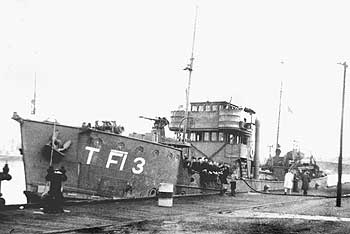When ready we set again and I can
honestly say that my experience of passing through the Pentland
Firth was the worst weather I ever encountered. We knew by this
time we going to Iceland. It was a rough journey and on arrival
at Reykjavik everything that had been fastened to the deck was
unfastened and most of it wrecked. The Allies against the wishes
of the natives had occupied Iceland and there was a non-fraternisation
policy, Recreation ashore consisted of beer (two bottles only)
at the American base, a café or the Cinema. One night a
mate and myself found ourselves in a café late at night,
when all hell broke loose. I only have a vague recollection of
what happened, but we both finished up in the local nick and later
in front of the skipper.
We went out from Reykjavik to the Greenland
sea and the Artic on patrol during which time most of the depth
charges were ejected due to Asdic warnings. On one occasion we
were trapped for three days in a field of ice floes and ran short
of food. We made it down a fiord to a small village and obtained
some supplies. Back in Reykjavik I was taken ill and put ashore.
When I was O.K again I was unable to go back to Wisteria as she
was out on patrol again so I was put on to a drifter ' Fairhaven.
which the skipper managed to damage coming back to Port. Fairhaven
was repaired by the Icelanders and we were then ordered to return
to the U.K. The Icelanders must not have made a very good job
because when we were near the Westman Islands the boat started
sinking, water was coming in faster than it could be got out and
it was plain Fairhaven was going down. . A whaler in the convoy
came along side and we had to jump from one boat to the other,
no easy feat in a rough sea as the whaler couldn't come to close
with both ships rolling. We all made it and even saved the rum
ration! We were dropped off by the whaler at Kirkwall in the Orkney
Islands and from there to Cape Wrath and then a two day journey
back to Lowestoft by train from where I went on two weeks survivors
leave.
Back in Lowestoft I sat a leading stoker exam.
It was now January 1945 and it was obvious that the war was coming
to an end before long, and administrative staff would be needed.
When requests were made for people to sit for an exam to R.P.O,
I did so, passed and spent the rest of my service in the drafting
office at the Nest. being demobbed in July 1946.
 |
HMT Wistaria - Built at Southbank-on-Tees by Smith's Dock, launched 1939 and completed as a minesweeper. Joined the 11th A/S Strike Group at HMS Bacchante, Aberdeen and in 1940 was sent with other ships to assist with the Norwegian Campaign.
This picture taken by Chris Chapman 1940. |
© William Carr. & Nick Clark 2006
|